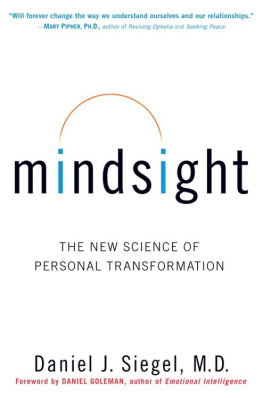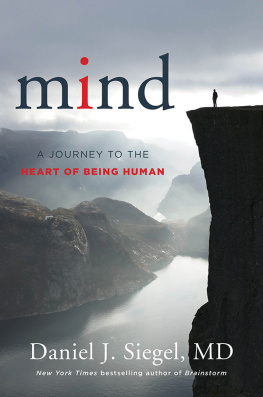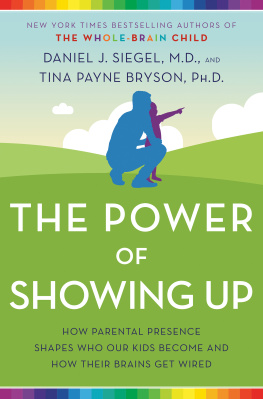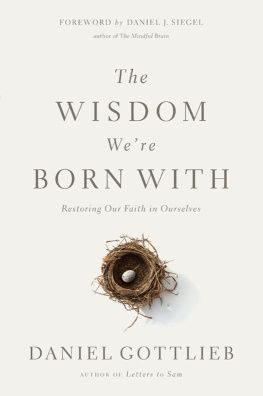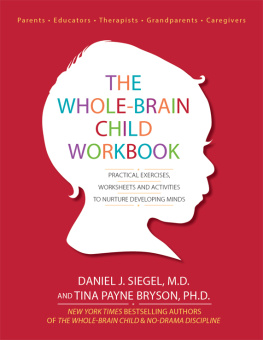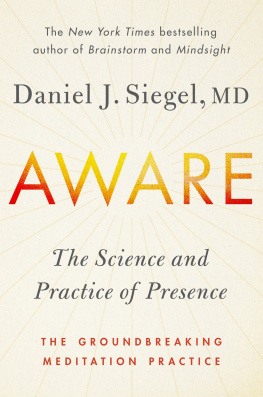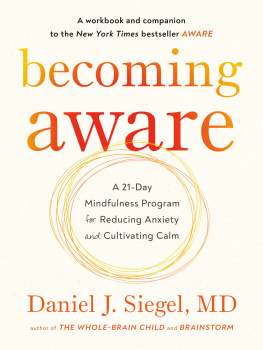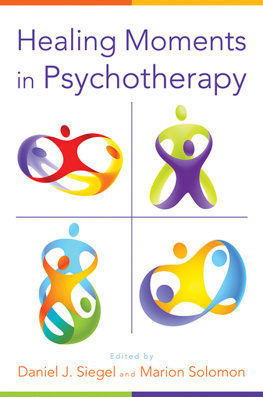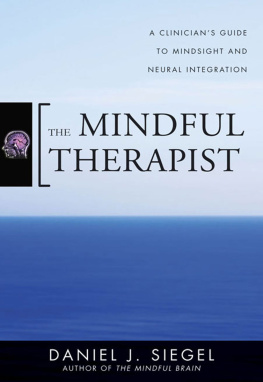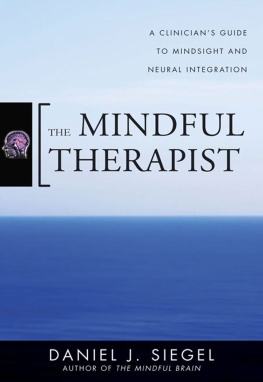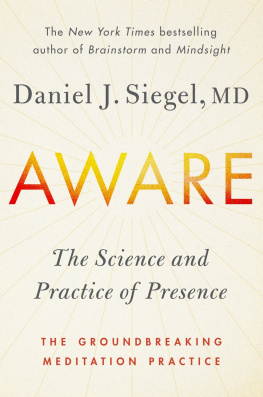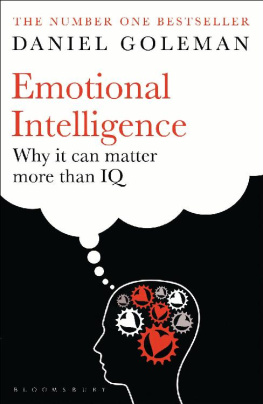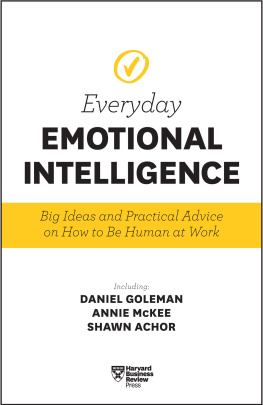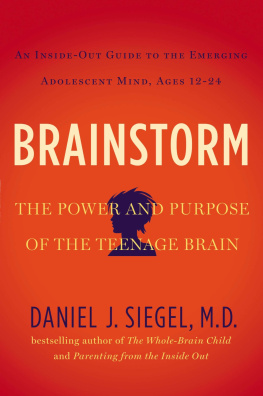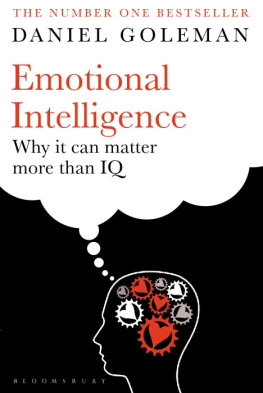ACKNOWLEDGMENTS
This project has been developing over my entire life, and many, many people have shared the journey leading to the ideas for this book. From the first days of medical school, my patients have served as a primary motivation for forming the principles underlying mind-sight. It has been a profound privilege to be invited into their lives, to share the pain and confusion of their struggles, the clarity and joy of their triumphs. Through the opportunity to be a part of their efforts to understand and change their livesto travel with them on an expedition to transform anguish and despair into resilience and empowermentI have been given insights both personally and professionally in ways I could never have dreamt possible. These insights are the direct source of motivation to write this bookand it is the collected wisdom of my patients struggles that has given voice to the notion of mindsight.
I am deeply appreciative of my teachers for their guidance during my clinical and research training in psychiatry: Drs. Gene Beresin, Leston Havens, David Herzog, and the late Tom Whitfield in medical school; Drs. Gordon Strauss, Joel Yager, and the late Denny Cantwell and Robert Stoller in residency; and Drs. Robert Bjork, Chris Heinicke, Eric Hesse, Mary Main, and Marion Sigman in research training.
I thank my clinical colleagues for their support over the thirty years since I began my medical training. Students and colleagues at the Mindsight Institute have also been a wonderful source of lively discussions as the field of interpersonal neurobiology has been emerging. Many read earlier versions of this manuscript and I thank them for their suggestions and questions over the years. Especially helpful have been Bonnie Badenoch, Eric Bergemann, Tina and Scott Bryson, Lynn Cutler, Erica Ellis, Donna Emmanuel, Stephanie Hamilton, Joan Rosenberg, and Aubrey Siegel. I also thank my interns, Gabe Eckhouse, Deanie Eichenstein, and Ellen Streit, together with Beth Pearson, Tom Pitoniak, and Kate Norris at Random House, for their insightful immersion in the manuscripts final editing. Brian McLendon and Carolyn Schwartz have also been an important part of Random Houses efforts to bring this book to the public eye.
The Global Association for Interpersonal Neurobiology Studies has been a great gathering of like-minded people who share this notion that seeing the mind can enhance our individual and collective lives. I first began my career in the academic world and am happy as a clinician to keep one foot planted in scientific pursuits at the Foundation for Psychocultural Research/UCLA Center for Culture, Brain, and Development (CBD) and at the Mindful Awareness Research Center (MARC). The individuals associated with those two university centers provide the intellectual grounding that a synthesizer working in the subjective world of psychotherapy needs to continue to be challenged and stimulated to think rigorously. I thank Sue Smalley, Diana Winston, and Susan Kaiser Greenland at MARC; and Mirella Dapretto, Patricia Greenfield, Eli Ochs, Alan Fiske, Marco Iacoboni, and Allan Schumann at CBD. I also want to thank all the writers who have contributed to the interpersonal neurobiology series, where we try to bridge research, clinical practice, and educationespecially Lou Cozolino and Allan Schore, who have also been friends and colleagues since the first days of this effort to synthesize science and psychotherapy. At the Lifespan Learning Institute, I am grateful to Marion Solomon and Bonnie Goldstein for their never-ending support and camaraderie. Id also like to express my gratitude to the Atlas, the Attias, and the Kirlin Family Foundations for their support.
Colleagues and friends have been instrumental in my personal and intellectual growth and have furnished invaluable reflections on this work as it unfolded. Diane Ackerman, Dan Goleman, Jon Kabat-Zinn, Jack Kornfield, Regina Pally, and Rich Simon have become siblings in my heart, and I thank them for their friendship and support at many a challenging moment. I also want to remember my dear friend and colleague John ODonohue, who left this world too soon but whose magnificent books and love of life continue to inspire me every day.
My two children have given me invaluable support; their good humor and lively debates keep me on my toes and teach me never to take anything for granted. As those with adolescents may know, it is not possible to become complacent with who you are when confronted with teenage honesty.
My wife, Caroline Welch, is a fountain of wisdom and encouragement and an inspiration in my life. Caroline read every version of the manuscript as it evolved, and her contributions have been an essential part of the books creation. I am profoundly grateful for our relationship.
Id like to give a deep bow of thanks to my literary agent and friend, Doug Abrams, who shares a dedication to bringing ideas into the world that, one page at a time, may move it even one small step in a positive direction. My own life has been enhanced because of our connection. When we set out on this project, we were looking for a publisher who might share its vision. Finding Toni Burbank at Bantam was a dream come true. Over the years since we first met, Toni has kept up her reputation as a brilliant and supportive award-winning publisher. I have been fortunate that she was not only interested in acquiring this project, she also wanted to be the hands-on editor for it. Our relationship grew as we pored over the pages of each chapter, and Ive come to learn firsthand that she is not only keenly intelligent and a wizard with wordsshe is also fun and funny. I appreciate her dedication to this project, and have marveled at her capacity to use mindsight to keep the readers experience in focus as we wrestled with the details of science and the flow of the narratives. Joining this project as the anchor editor, Beth Rashbaum has also been extremely helpful and a great asset to our team. Her enthusiasm, insightful suggestions, and broad perspective enabled the addition of many vital final touches. I cannot thank Beth, Toni, and Doug enough for being companions on this journey to bring Mindsight to life.
APPENDIX
Here are a dozen basic concepts and related terms and ideas that form a foundation for our approach of mindsight, integration, and well-being.
1. The Triangle of Well-Being reveals three aspects of our lives. Relationships, Mind, and Brain form the three mutually influencing points of the Triangle of Well-Being. Relationships are how energy and information is shared as we connect and communicate with one another. Brain refers to the physical mechanism through which this energy and information flows. Mind is a process that regulates the flow of energy and information. Rather than dividing our lives into three separate parts, the Triangle actually represents three dimensions of one system of energy and information flow.
2. Mindsight is a process that enables us to monitor and modify the flow of energy and information within the Triangle of Well-Being. The monitoring aspect of mindsight involves sensing this flow within ourselvesperceiving it in our own nervous systems, which we are calling Brainand within others through our Relationships, which involve the sharing of energy and information flow through various means of communication. We then can modify this flow through awareness and intention, fundamental aspects of our mind, directly shaping the paths that energy and information flow take in our lives.
3. A system comprises individual parts that interact with one another. For our human systems, these interactions often involve the flow of energy and information. Energy is the physical property enabling us to do something; information is the representation of something other than itself. Words and ideas are examples of units of information we use to communicate with one another. Our relationships involve our connection to other people in pairs, families, groups, schools, communities, and societies.

